Let’s learn about the half rest also called minim rest (British).
First of all we need to understand what a music rest is. A rest is a period of silence in music. It’s a period when one must stop playing. Notes and rests are musical symbols that tell you when to play and when not to play. Rests are often as important as the notes themselves. It’s the space between the notes that really makes the music come alive.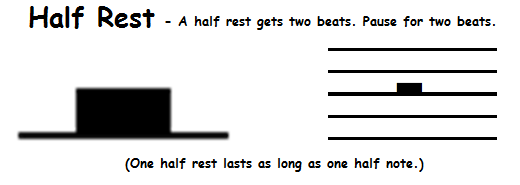
Highly Recommended: Click here for one of the BEST piano/keyboard courses I’ve seen online.
A half (minim) rest is drawn as a filled-in rectangle sitting on top of the middle line of the musical staff. It looks like a hat. It’s height is half the distance between lines. It looks similar to a whole rest, but the difference is that it sits above the third line while the whole rest hangs from the fourth line. (Staff lines are numbered starting from the bottom).
We already looked at the quarter rest in another lesson. A half rest is simply a rest that is twice as long in time duration as a quarter rest. Two 1/4 rests = one 1/2 rest. A 1/2 rest is half the length of a whole rest. Two 1/2 rests = one whole rest. When you come across a 1/2 rest in a piece of music, you must pause for two beats. This rest is of the same time duration as a half note. 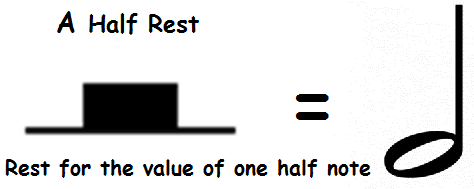
To help you better understand note and rest values, let’s talk for a short while about time signatures.
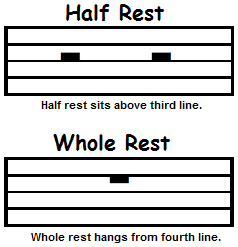 Time signatures tell you the number of beats in a measure and the type of note that should get one beat. So in a 4/4 time signature, the top number indicates that there are four beats in a measure and the bottom number says that a quarter note gets one beat. In other words there are 4 quarter notes in a measure. A 3/4 time signature indicates that there are 3 quarter notes in a measure.
Time signatures tell you the number of beats in a measure and the type of note that should get one beat. So in a 4/4 time signature, the top number indicates that there are four beats in a measure and the bottom number says that a quarter note gets one beat. In other words there are 4 quarter notes in a measure. A 3/4 time signature indicates that there are 3 quarter notes in a measure.
So in 4/4 time, it is clear to see that while a quarter note gets four beats in a measure, a half note gets two beats and a whole note gets four beats. The same applies to rests.
Counting Half Rests
Here are a few examples of half notes and the count that they receive in a measure. Count “1-2-3-4” steadily or make use of a metronome at a tempo of about 60 beats per minute.
In example one, we can see that each half note gets two beats. On your piano, play F on the first and third beats and each time hold the note for two beats.
In our second example, we rest on the first beat for two beats and we play the note F on beat 3, for two beats. 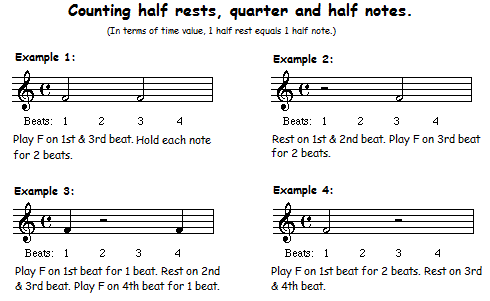
In our third example above, we play a quarter note on beat one for one beat, rest for two beats, and play a quarter note on beat 4.
In our fourth example, we start by playing F on beat one, we hold it for two beats, and rest for the other two beats.
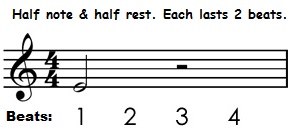 Free piano lesson about rests, note values and time signatures.
Free piano lesson about rests, note values and time signatures.
Go here to learn more about half rests and piano notes.
Go here to learn about my top recommendation for learning how to play the piano.